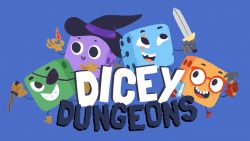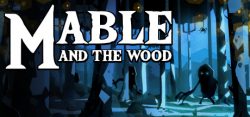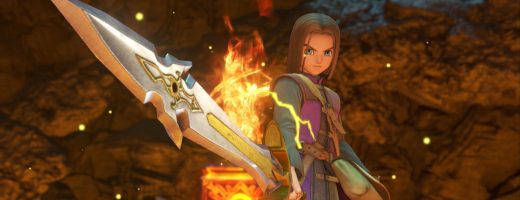E3 Indie Round-Up
At E3, it’s easy to get overwhelmed by the bombastic sights and sounds aimed at catching your attention. Big-name publishers pour their resources into pulling you one way or another. But there’s another side to the convention and its associated events happening throughout Los Angeles over the course of the week: the indie scene is alive and well at E3, and is being steadily represented more and more with each passing year.
Here is our attempt to recognize some of the worthwhile indie games at this year’s E3. Enjoy!
Anew: The Distant Light
At the indie event The Mix, we got a chance to try out the Metroidvania title Anew: The Distant Light, and chat with its devs for a little bit. As you might expect, it features 2D levels, but with a lot of verticality. After a bit of initial play, I managed to get my hands on the jet pack upgrade, allowing me to add some upward momentum to my jumps and reach higher platforms, and this opened up the levels considerably more. The setting is very sci-fi, compared to the current tendency of fantasy or gothic Metroidvania titles, with blaster gunplay and a built-in shield ability.
The levels featured plenty of enemies and Super Meat Boy-esque saw blade traps, but eventually opened into larger areas in which falling down and swimming through subterranean lakes were required. One of the highlights of the demo was finding a colossal mech, kicking the enemy piloting it out, and taking it over myself for some well-deserved, if a bit lumbering, payback to any enemy in my path. One noticeable thing to mention that held the game was that, at this point, the jumping controls occasionally felt a bit floaty, jet pack not withstanding. — Pascal Tekaia
Dicey Dungeons
As far as indie games go, no other game I played at E3 this year had as simple a premise, presentation, and execution as Dicey Dungeons, and no other game got me hooked as quickly and completely as this one. Its setup is quickly explained: explore simple, node-based dungeons, picking up loot and fighting enemies using dice-roll mechanics. Despite its simple graphical style, the level of creativity in the enemy designs — and of course the addictively simple nature of rolling the dice that every board-game enthusiast knows well — had me hooked.
There are a number of player characters to choose from, although the finished game may require completing a full campaign as, say, the Warrior before the next playable character is unlocked. Each class has its own dice mechanics; the Warrior uses a very simple system where the player rolls a number of dice and simply assigns some of them as damage numbers while re-rolling others. By contrast, the Robot uses a unique blackjack-based system to roll as many dice as the player wants, as long as their combined total doesn’t exceed a certain value, then assigning those dice to various abilities and actions.
Each enemy type also has its own system of dice-based combat actions, including inflicting stat debuffs that may “burn” one of your dice, reducing the total number of dice the player gets to use. Some attacks simply take a die’s face value into account; other actions allow continued stacking of dice until a certain total is reached; still others only work with odd or even rolls, or dice rolls only up to a certain number. The game gets really challenging really fast, something I wouldn’t have expected given the simple layout and mechanic.
Unfortunately, it’s a brief experience, as each campaign only takes around 45 minutes or so to complete, although that may yet change before the game is done. Even so, with multiple campaigns, randomized dungeon layouts, loot to find, and the unpredictable nature of dice, simply popping in for a few rounds of play anytime promises to be an entertaining experience. — Pascal Tekaia
Mable and the Wood
Mable and the Wood is another title I was able to check out at The Mix. Calling it another pixel-art Metroidvania title, while accurate, would be ignoring one of the game’s most unique aspects: its unconventional combat and exploration controls. Mable is a being who has been summoned by a dark cult for a nefarious purpose, and resembles a little girl. This is important because Mable has all the physical limitations that a child her size would have. Deciding to chart her own course rather than what the cult has asked of her, she goes off to explore the dark woods and the larger world around them.
Though equipped with a hefty broadsword to slay her enemies with, Mable, of course, is far too slight to heft such a mighty weapon. So she simply leaves the sword stuck in the ground. However, being magically bound to the weapon through the summoning ritual, she can never get very far away from it; this is represented by an on-screen dotted line connecting the two. The way Mable attacks is by running and jumping over enemies, putting them between herself and her grounded sword. Then, at the release of a button, the player can make the sword fly back into Mable’s hand, slicing anything that stands between them. It’s a physics-based combat system the likes of which I’ve never seen, and after only a few moments it even started to feel fairly natural.
The same, however, cannot be said for the other abilities Mable acquires by slaying bosses over the course of her quest. Slaying the dreaded Spider Queen at the end of the first level, Mable received the power to turn into a spider herself, which became vital in traversing the next level. As a spider, Mable’s moveset changes, and she is now able to spit projectile spider webs to break obstacles in her path and pull herself to otherwise impossible-to-reach locations. But here, too, the game’s unusual control scheme appears, and this time I found it very difficult, at least in the short space of time I had, to accurately aim, shoot, move, and ascend in spider form. I didn’t get a chance to see other forms or abilities, though I’m sure there are more clever ideas in store; I just hope the controls can get ironed out to feel more natural by the time the game releases. — Pascal Tekaia
Project Witchstone
Spearhead Games’ Project Witchstone aims to take the concept of “sandbox RPG” to a whole new level. The turn-based action RPG features no story other than what you build for yourself. The designers have crafted a living world where NPCs lead regular lives, and opportunities for being an adventurous hero or dastardly villain exist, but it’s up to the player to seek out and shape their own narrative.
In my short time checking out the game, there were quite a few ways shown to me in which the player is able to influence the world around him. There are two factions at war with each other in the world, the Unbound and the Ashcross. Players can join one or the other, or prefer to lead a non-partisan existence altogether. Events happen all around the player that they can choose to intervene in if it suits them; for example, seeing some soldiers roughing up a village citizen may lead some players to join in to protect the citizen, others to join the beating, and still others to simply watch or walk away. The world will change based on player choice. Players are also able to craft specific dialog orders to be able to persuade some NPCs into doing what you want them to. Perhaps you’ll become a merchant prince; maybe your aim is to rise to the rank of monarch; or you have your sights set on being a murderous villain. The choice is yours.
While Project Witchstone has a very familiar isometric fantasy RPG look, it may be a bit too open-ended for me. For players like me, who prefer a bit of a narrative to be presented, there are still quests to take on that do a bit of story-telling in and of themselves, and the turn-based combat feels natural and fluent. But in order for me to become fully invested in a game of this sort, I need an option for a bit more guidance — a full-fledged story to follow throughout the game. Sandbox enthusiasts, however, may find quite a bit to their liking here. — Pascal Tekaia
Trials of Fire
I had a chance to check out Whatboy’s Trials of Fire, a game that offers a mix of survival, strategy, and card game mechanics. The demo started with the opening of a book through the pages of which players can flip to read the story. Rather than spending a lot of time on background, players are thrown right into the story and can opt to click on highlighted keywords to learn more. As I flipped through the pages of the story, I eventually came to an interactive section where an area map with trees and buildings sprung up from the pages with an effect that was reminiscent of physical popup books. On this map I could take control of my party and move around with cardboard-like sprites that slid across the screen in the style of board game pieces. While these effects were simple, they were really effective in eliciting a deep sense of the adventure that was about to unfold.
I wandered through the map and came to an area that triggered a battle. My three member party was converted to circular bottlecap-like pieces with faces and stats, and were placed on a hexagonal grid to battle with the enemies. Each of the three characters drew a set of three cards to use. Some cards allowed me to move on the grid, while others allowed me to attack, defend, or use any number of other abilities. The map also had environmental obstacles which I could exploit to gain an advantage and which can also interact with some of the card abilities – for example to bounce projectiles off of. Each card costs a set amount of Will which can be earned by sacrificing cards in your hand. In other words, you must choose some cards to discard so that you can play others. The battle merged the spatial characteristics of strategy RPGs with the execution mechanics of a card game into a combination that worked very well. The random chance to draw cards, the choice of whether to use them now or wait for synergies with cards you may or may not draw, and the resource management to actually play the cards worked well with strategies such as surrounding enemies, executing line and AOE attacks, hiding weak characters behind the tank, or taking refuge behind obstacles. There were many options on how to play, and some encounters were difficult enough to require me to use every possible advantage — and still I lost to the boss battle I faced.
After I finished the battle I leveled up, which allowed me to pick from more powerful cards to replace weaker ones in my deck. Leveling up and choosing which new ability cards to grab makes for one part of the deck building. The other part of deck building is done through equipping items. As players explore the world and win battles they can find different equipment for each of their characters, and each manifests as a card that gets added to the deck. Unlike cards gained from leveling up which are class-specific, equipment and the associated cards can be shared across multiple characters. For example, when I upgraded my wizard’s wand, I was able to give the wand to my ranger, and in this way I passed that ability from one character to another. Overall, the deck-building aspect of the game felt more streamlined and simplified than dedicated TCGs but still offered enough options to require consideration.
After setting up my characters with new class cards and equipment cards, I continued on with the story, and this required me to explore the map once more. I noticed that as I explored the map I got tired, and had to rest, which then used up my food supplies. If you don’t rest, or if your characters are injured in battle, you can find yourself at a disadvantage in upcoming battles. That’s because fatigue and injuries manifest as cards in your deck that cannot be discarded once drawn, and cost Will to play for no added benefit. If you draw them, you must then choose whether to keep them in your hand and use up a valuable card slot, or to play them and essentially waste your card-playing resource. It can get quite punishing and snowball out of control because the cards can be drawn again and again even after played so players must be weary to cure any such injuries and rest up before battles — which in turn requires managing food and other resources.
I really enjoyed my experience with Trials of Fire and the variety of mechanics it brought to the table, as well as the visual and interaction design decisions that are clearly aimed at fans of physical games and classic CRPGs. — Charalampos Papadimitriou


























Recent Comments